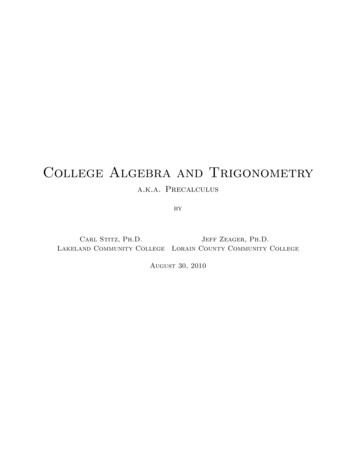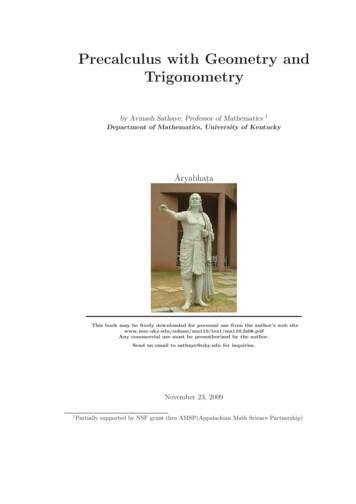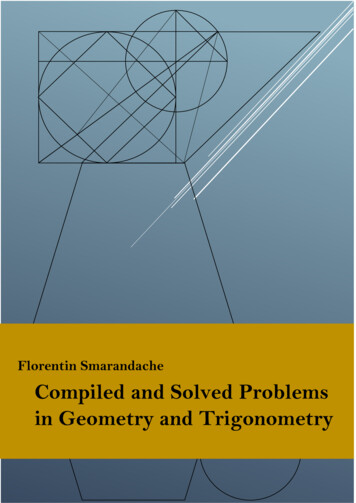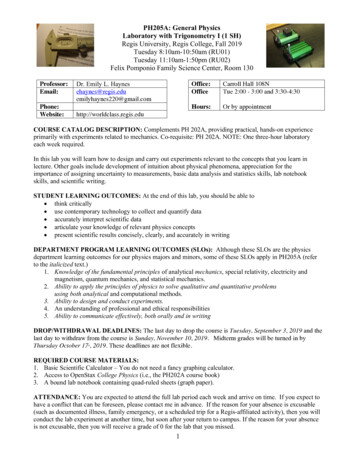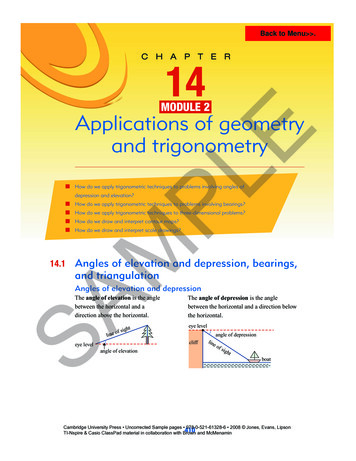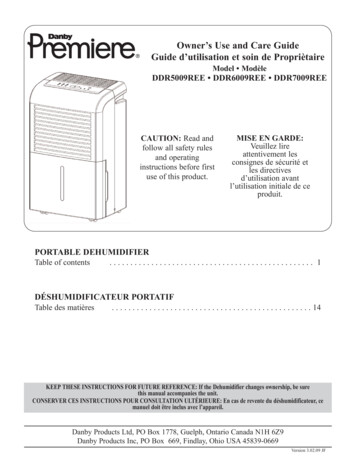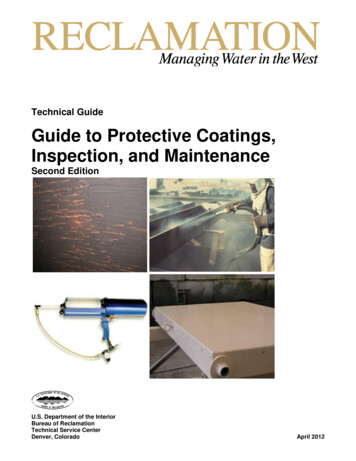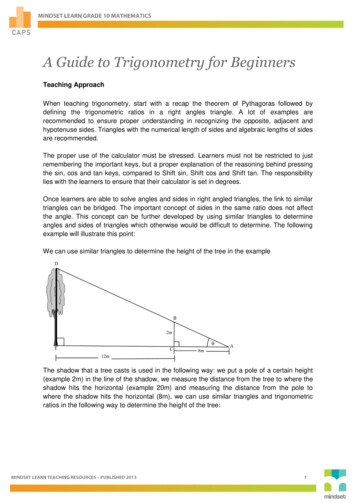
Transcription
A Guide to Trigonometry for BeginnersTeaching ApproachWhen teaching trigonometry, start with a recap the theorem of Pythagoras followed bydefining the trigonometric ratios in a right angles triangle. A lot of examples arerecommended to ensure proper understanding in recognizing the opposite, adjacent andhypotenuse sides. Triangles with the numerical length of sides and algebraic lengths of sidesare recommended.The proper use of the calculator must be stressed. Learners must not be restricted to justremembering the important keys, but a proper explanation of the reasoning behind pressingthe sin, cos and tan keys, compared to Shift sin, Shift cos and Shift tan. The responsibilitylies with the learners to ensure that their calculator is set in degrees.Once learners are able to solve angles and sides in right angled triangles, the link to similartriangles can be bridged. The important concept of sides in the same ratio does not affectthe angle. This concept can be further developed by using similar triangles to determineangles and sides of triangles which otherwise would be difficult to determine. The followingexample will illustrate this point:We can use similar triangles to determine the height of the tree in the exampleThe shadow that a tree casts is used in the following way: we put a pole of a certain height(example 2m) in the line of the shadow, we measure the distance from the tree to where theshadow hits the horizontal (example 20m) and measuring the distance from the pole towhere the shadow hits the horizontal (8m), we can use similar triangles and trigonometricratios in the following way to determine the height of the tree:
28xIn ADE : tan 20x 220 2 x 20 88 x 5mOther uses of trigonometry and similar triangles must be highlighted to ensure learners seethe relevance of trigonometric definitions. Trigonometry and Similar triangles are used inengineering, architecture, construction etc.In ABC : tan Hints on solving trigonometry problems: If no diagram is given, draw one yourself.Mark the right angles in the diagram.Show the sizes of the other angles and the lengths of any lines that are knownMark the angles or sides you have to calculate.Consider whether you need to create right triangles by drawing extra lines. For example,divide an isosceles triangle into two congruent right triangles.Decide whether you will need Pythagoras theorem, sine, cosine or tangent.Check that your answer is reasonable.The hypotenuse is the longest side in a right triangle
Video SummariesSome videos have a ‘PAUSE’ moment, at which point the teacher or learner can choose topause the video and try to answer the question posed or calculate the answer to the problemunder discussion. Once the video starts again, the answer to the question or the rightanswer to the calculation is given.Mindset suggests a number of ways to use the video lessons. These include: Watch or show a lesson as an introduction to a lesson Watch of show a lesson after a lesson, as a summary or as a way of adding in someinteresting real-life applications or practical aspects Design a worksheet or set of questions about one video lesson. Then ask learners towatch a video related to the lesson and to complete the worksheet or questions, either ingroups or individually Worksheets and questions based on video lessons can be used as short assessments orexercises Ask learners to watch a particular video lesson for homework (in the school library or onthe website, depending on how the material is available) as preparation for the next dayslesson; if desired, learners can be given specific questions to answer in preparation forthe next day’s lesson1. Introduction to TrigonometryThis video gives brief description of how trigonometry was first discovered and used. Italso describes the practical application of trigonometry through the theodolite, as used byland surveyors.2. Introduction to Sin, Cos and TanThis video covers the fundamental definitions of the trigonometry. It explains thattrigonometry is ultimately the relationship between ratios of sides of triangles with respectto an angle in that triangle.3. Basic Use of Sin, Cos and TanIn this lesson we will use sin, cos and tan ratios in right angled triangles. We start byrevising the definitions.4. Using to Calculating a SideThis video covers the first of the application videos in which we use the trigonometricratios to determine the length of a side in a right angled triangle. The emphasis is onchoosing the correct trigonometric ratio.5. Using Trigonometric to Calculate an AngleThis video covers the second of the application videos in which we use the trigonometricratios to determine the size of an angle, given at least two sides in the right angledtriangle.6. Introducing Trigonometry on the Cartesian PlaneIn this lesson we look at we will be looking at the trigonometric ratios on the CartesianPlane.
7. Application of Trigonometry on the Cartesian PlaneIn this video we apply what we know about trigonometric ratios on the Cartesian Plane.We determine lengths of sides by sketching a right angle triangle in the correct quadrantsaccording the given information.8. Introducing Cosec, Sec and CotThis lesson introduces learners to the three reciprocals of sign, cos and tan, namelycosec, sec and cot9. Introducing Special AnglesIn this video we introduce special angles of which the trigonometric ratios can be derivedwithout the use of a calculator. We derive these special triangles by using the CartesianPlan with a circle with centre at the origin and with radius 2.10. Solving Basic Trigonometric EquationsIn this video we solve trigonometric equations. Learners are exposed to solvingequations using a calculator and solving equations without the use of a calculator. Theimportant calculator steps are outlined.11. Angles of Elevation and DepressionIn this video we use trigonometric ratios to find the length of sides and the size of anglesin two dimensional sketches. An angle of elevation and an angle of depression are alsodiscussed in this lesson.
Resource MaterialResource materials are a list of links available to teachers and learners to enhance their experience ofthe subject matter. They are not necessarily CAPS aligned and need to be used with discretion.1 Introduction toTrigonometry2 Introduction to Sin, Cos andTan3 Basic Use of Sin, Cos andTan4 Using Trigonometry toCalculate a //www.ehow.com/m/list 7769833 /partc/http://en.wikipedia.org/wiki/Trigonometric tmhttp://teachertube.com/viewVideo.php?video id /watch?v b1PBnTjWSiA&feature related5 Using Trigonometric toCalculate an Angle6 Introducing Trigonometry onthe Cartesian Plane7. Application of Trigonometryon the Cartesian Plane8. Introducing Cosec, Sec px?file Trigonometry This page defines trigonometry.This script explains to us the usesof trigonometry in the industry andin everyday life.A resource on trigonometry.Summary of the definitions oftrigonometric ratiosThe definition of the sin, cos andtan ratiosVideo on the definition of the sin,cos and tan ratios.This video gives examples offinding the lengths of sides usingthe trigonometric ratios.This page covers the calculationsof sides of a right angled triangleusing trig ratiosGives us examples of how to findthe size of a side in a right angledtriangle.This page gives useful hints onhow to calculate the lengths andangles in right angled triangles.This video gives examples of howto calculate the angle in a rightangled triangle.This page gives a summary of thetrig ratios in all 4 quadrants.This page gives us a summary ofthe trig ratios in all 4 quadrants.This page gives us a summary ofthe trig ratios in all 4 quadrants.A text book sectionA summary of the trig ratios in all4 quadrants as well as examplesof trig ratios in all 4 quadrants.This page defines the reciprocalratios of sin, cos and tan.This page defines the reciprocalratios of sin, cos and tan.This page defines the reciprocalratios of sin, cos and tan. It alsoincludes some useful examples.This page gives a summary of allthe special angles and the valueof sin, cos and tan ratios of thespecial angles. An exercise withfull solutions is included.
http://www.youtube.com/watch?v nVTtSE5nv7c9. Introducing Cosec, Sec andCot10. Solving Basic p://www.analyzemath.com/highschool math/grade 10/trigonometry.html11. Angles of Elevation /trigonometric-ratios.htmlThis video explains the specialangles in a right angled triangle aswell as the values of the trig ratiosof the special angles.This page explains the solution totrigonometric equations with someuseful examplesThis page includes a video and anexercise page on solvingtrigonometric equationsThis page gives some goodexamples of solving twodimensional problemsThis page gives some goodexamples of solving twodimensional problems and step bystep explanations.This page gives some goodexamples of solving twodimensional problems. It alsoincludes exercise on twodimensional problemsPage 60 – 62 : this page givessome good examples of solvingtwo dimensional problemsGives us a summary plusexamples of trigonometricfunctions in the Cartesian Plane Page 63This page includes a video plus adetailed explanation oftrigonometric functions in theCartesian Plane.
TaskQuestion 1In PQR, Qˆ 900 , PQ 12cm, QR 5cm. Write down the value of each of the following:1.1 sin P1.2 cos P1.3 tan PQuestion 2In ABC, Bˆ 900 , side AB c, BC a and AC b. Write in each of the following in terms ofa, b and c.2.1 sinA2.2 sinC2.3 cosA2.4 cos C2.5 tan A2.6 tan CQuestion 3Refer to the given sketch.Write down two ratios for:3.1 sin θ3.2 cos θ3.3 tan θ
Questions 4All answers must be given correct to two decimal places, where applicable.Determine the length of x in the given sketches:Question 5Determine the value of x and y in the given diagram.Question 6In ΔDEG, DE 15cm. Determine the length of DGQuestion 7Determine the size of θ (correct to one decimal place) in each of the following sketches.
Question 8Determine the value of x and y in the diagram below (correct to one decimal value)Question 93If cosP - and 00 P 1800 , determine with the aid of a sketch5and without the use of a calculator:9.1sin P9.2tan P9.3sin 2 P cos 2 PQuestion 10Given : tan 6, with 900 3600.13Determine with the aid of a sketch and without the use of a calculator:10.1cos 10.27sin 14cos2 10.3cos tan Question 11Use the given triangle to determine the value of:11.1 cosec α11.2 sec α11.3 cot α
Question 12Use the given triangle to answer the following questions.Determine the value of:12.1 Cosec 75 12.2 Sec 149 12.3 cot 256 Question 13Determine the value of each of the following without the use of a calculator:13.1 sin 30 cos 60 13.2 cos 30 sec 30 13.3 cosec 30 cos60 cot30 tan45 Question 14Determine the value of θ for 0 θ 90 if:14.1 3sin θ – 2 0,314.2 tan 2θ 914.3 cosec θ 2,5Question 15If cos 3and sin 0, find tan without using a calculator.2Question 16If sin 2and cos 0 , determine without finding the value of θ and with the aid of a3sketch, the value of16.1 cos 16.2 tan 2 sin Question 17Marilyn and Vijay are standing on opposite sides of a bridge. They want to calculate the length of thebridge. Marilyn is at point A and Vijay at point B. The angle of depression from A to the bottom of thegorge, D, is 55 and the angle of depression from B to D is 68 . If the length of BD 36m, help them tocalculate the length of the bridge.
Task AnswersQuestion 1Question 2abc2.3 cos A ba2.5 tan A c2.1 sin A cba2.4 cos C bc2.6 tan C a2.2sin C Question 3BDBCCD3.2 cos BCBD3.3 tan CD3.1 sin Question 4x70 7 sin 35 x4.1 sin 350 x 4, 02x100 10 cos 65 x4.2 cos 650 x 4, 23x200 20 tan 72 x4.3 tan 720 x 61, 55ABACBCcos ACABtan BCsin
Question 55x0 x cos 48 5cos 480 x5cos 480 x 7, 47 cos 480 x tan 32, 7 0 3y y y tan 32, 7 0 33tan 32, 7 0 y 4, 67 tan 32, 7 0 y Question 6DF15 15 15sin 510 DFsin 510 DF 11, 66cmDF 11, 66 DGDG DG DG cos 200 11, 66cos 200 cos 200 DG Question 71219 39, 207.1 sin 810 36, 90207.3 tan 15 53,107.2 cos 11.66 12, 41cmcos 200
Question 825 x 21,80tan x tan 380 52 y (2 y ) (2 y ) tan 380 55 tan
A Guide to Trigonometry for Beginners Teaching Approach When teaching trigonometry, start with a recap the theorem of Pythagoras followed by
